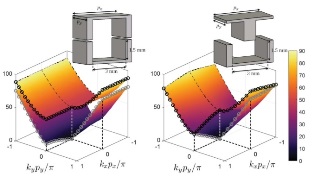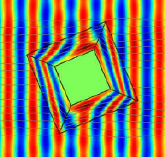Electromagnetic metamaterials and metasurfaces
Metamaterials are materials that possess unusual macroscopic electromagnetic behaviour created by their sub-wavelength periodic structure. This field of research began its life in the realms of theoretical physics, moving more recently into the engineering domain. The full opportunities offered by metamaterials were finally exploited when the concept of metasurfaces was recently introduced. Metasurfaces are thin metamaterial layers, which can be employed to produce unusual reflection and transmission properties of incident plane waves, to prevent the propagation of electromagnetic waves or to guide surface waves with a plasmonic response. These metasurfaces are used to control the propagation of electromagnetic surface waves by modulation of the surface impedance.

1) Higher-symmetric structures: ETK is developing research on the analysis and understanding of higher-symmetric structures. There are two types of higher symmetries: glide and twist symmetries. These structures can be employed to reduce the dispersion properties of periodic structures, leading to low-dispersive lenses and leaky-wave antennas. Additionally, our recent work at KTH has demonstrated that glide-symmetric configurations can also be employed to produce wide Electromagnetic Band Gap (EBG) surfaces, which find application in high frequency devices as low-loss flanges, and cost-effective gap-waveguide technology. This work is led by Oscar Quevedo-Teruel (oscarq@kth.se).

2) Analytical and numerical methods: At ETK, we are developing research on circuit models and mode matching to fast analyse and synthesize periodic structures, particularly for fully-metallic higher-symmetric structures. These structures find application in lens antennas, filters, phase shifters and leaky-wave antennas. Martin Norgren (mnorgren@kth.se) and Oscar Quevedo-Teruel (oscarq@kth.se) are working in this line of research.

3) Optical metamaterials: ETK is developing research studies on the propagation and scattering of waves in new types of complex materials, including materials with negative permeabilities and permittivities and their applications in the design of new types of optoelectronic devices. Prof. Sailing He (sailing@kth.se) is leading this research. He shares his time between KTH and Zheijang University, where he is Director of the Centre for Optical and Electromagnetic Research.
